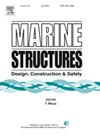Thermal instability behaviors of the subsea confined FGP-GPLs polyhedral pipeline under a temperature-rising field
IF 5.1
2区 工程技术
Q1 ENGINEERING, CIVIL
引用次数: 0
Abstract
Subsea pipelines are usually heated to reduce the viscosity and improve transportation efficiency during the transportation of crude oil. However, subsea pipelines may buckle under the rise of the thermal field. Therefore, this study employs a novel functionally graded porous (FGP) metal reinforced by graphene platelets (GPLs) and polyhedral profile to enhance the thermal stability of the encased subsea pipelines. The distribution of the pores and GPLs in the cross-section of the pipelines is determined by the Halpin-Tsai micromechanics theory and Gaussian random field. The geometric parameters of the polyhedral profile are defined. Geometric nonlinearity is considered. A radial displacement function is introduced to describe the deformation of pipelines. Based on the theory of thin-walled shells and the energy method, the temperature-displacement equilibrium paths may be traced, and the minimum and maximum temperature variation also may be obtained. Subsequently, comparative studies are conducted with the results of the other available studies. Good accordance indicates the present study is efficient and accurate. An improvement factor is quantified to discuss the effect of a polyhedral profile on thermal stability compared to a circular one. Finally, parametric evaluations are highlighted by analyzing the effects of pores, the weight fraction of the GPLs, polyhedral profile on the thermal buckling.
升温场下水下受限FGP-GPLs多面体管道热失稳行为
在原油输送过程中,通常对海底管道进行加热,以降低粘度,提高输送效率。然而,海底管道在热场的上升下可能会弯曲。因此,本研究采用了一种新型的功能梯度多孔(FGP)金属,由石墨烯薄片(GPLs)和多面体轮廓增强,以提高封闭式海底管道的热稳定性。利用Halpin-Tsai细观力学理论和高斯随机场理论确定了管道截面上孔隙和gpl的分布。定义了多面体轮廓的几何参数。考虑几何非线性。引入径向位移函数来描述管道的变形。基于薄壁壳理论和能量法,可以追踪温度-位移平衡路径,得到温度变化的最小值和最大值。随后,与其他现有研究的结果进行比较研究。良好的一致性表明本研究是有效和准确的。对改进因子进行了量化,以讨论多面体剖面与圆形剖面相比对热稳定性的影响。最后,通过分析孔隙、gpl的重量分数、多面体轮廓对热屈曲的影响,重点分析了参数评价。
本文章由计算机程序翻译,如有差异,请以英文原文为准。
求助全文
约1分钟内获得全文
求助全文
来源期刊

Marine Structures
工程技术-工程:海洋
CiteScore
8.70
自引率
7.70%
发文量
157
审稿时长
6.4 months
期刊介绍:
This journal aims to provide a medium for presentation and discussion of the latest developments in research, design, fabrication and in-service experience relating to marine structures, i.e., all structures of steel, concrete, light alloy or composite construction having an interface with the sea, including ships, fixed and mobile offshore platforms, submarine and submersibles, pipelines, subsea systems for shallow and deep ocean operations and coastal structures such as piers.
 求助内容:
求助内容: 应助结果提醒方式:
应助结果提醒方式:


